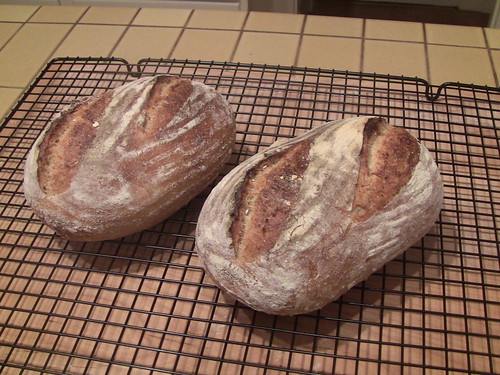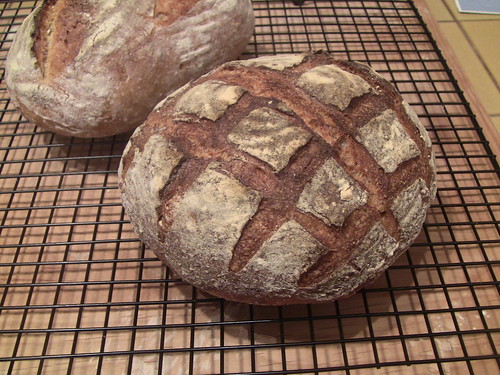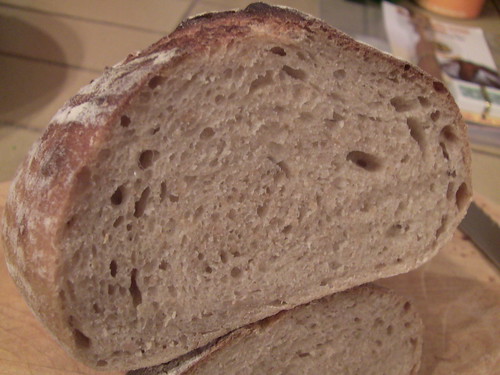
Cat and I spent the week of 3/3 through 3/10 on an expedition on the waters and islands around Southern Baja California. It was a glorious trip, with great up-close encounters with marine mammals and other local fauna.
My camera was busy trying to capture some sense of the wonderful natural world we experienced.

[That's a Grey Whale calf our friend Julie is about to pet]
On our return to civilization, once I got my work life under control, I found time to bake this weekend. I’m very glad my camera has had some stop-action exercise. My bread photos are much improved by a faster shutter (it looks like the loaves are lying absolutely still).
I tried a bit of an experiment in sourness. I took my tried-and-true San Francisco Country Sourdough formula and made it “country-er”. A bit more rustic and a bit sourer. I added more whole wheat and more rye (15% of each), used pumpernickel rye in the main dough, increased the hydration to 70% to compensate for the thirstier flour, and lengthened the fermentation time for the levain.
I made three loaves of about 525 grams each, two batards and one boule. The boule proofed in the basement (about 55 F) so I could bake it in a second batch in my small oven.
The result was a noticeably sourer, but still only medium-sour, bread, with a bit less open crumb (due to the coarser flour). This bread, like ones made with the basic SFCSD recipe, has a wonderful light, moist crumb and a moderately chewy crust. Very delicious.


I will definitely make this bread again. Maybe even take it up to 25% pumpernickel.
Here’s the new formula and procedure:
San Francisco Country-er Sourdough (Sourdough Pain de Campagne with more rye and whole wheat) version 3-17-12
Yield: 1570 grams: Two 785g Loaves; or Three 523 gram loaves; or…
Ingredients
LIQUID-LEVAIN BUILD
88 grams AP flour
24 grams Whole Wheat flour
24 grams light rye flour
170 grams Water, cold (45 F or so)
28 Mature culture (60% hydration)
FINAL DOUGH (70% hydration, including levain)
540 grams All-Purpose flour (70%)*
115 grams Whole wheat flour (15%)**
115 grams Whole rye flour (15%)***
470 grams Warm water (80 F or so) (61%)
17 grams Salt (2%)
312 grams Liquid levain (40.5%)
3-17 used CM Artisan Baker’s Craft (malted)
** 3-17 used CM Organic Hi-protein fine whole wheat
*** 3-17 used CM Pumpernickel rye
Directions
1. LIQUID LEVAIN: Make the final build 15 or so hours before the final mix, and let stand in a covered container at about 70°F
2. MIXING: Add all the ingredients to the mixing bowl, including the levain, but not the salt. Mix just until the ingredients are incorporated into a shaggy mass. Correct the hydration as necessary. Cover the bowl and let stand for an autolyse phase of 60 minutes. At the end of the autolyse, sprinkle the salt over the surface of the dough, plus a few drops of water to moisten the surface, and finish mixing 5 minutes. The dough should have a medium consistency.
3. BULK FERMENTATION WITH S&F: 3 hours. Stretch and fold the dough in the bowl twice 20-strokes at 60-minute intervals. If the dough has not increased in size by 75% or so, let it go a bit longer.
4. RETARDED BULK FERMENTATION (optional): After second S&F on board, form dough into ball and then place again in lightly oiled bowl. Refrigerate 8-20 hours, depending on sourness desired and scheduling convenience.
5. DIVIDING AND SHAPING: [Note: if bulk retarded, let dough come to room temperature for 30-90 minutes before pre-shaping.] Divide the dough into pieces and pre-shape. Let sit on board for 30 minutes, and then shape into boules or batards or baguettes.
6. PROOFING: Approximately 1.5 to 2.5 hours at 72° F. Ready when poke test dictates. Pre-heat oven to 500 with steam apparatus in place.
7. BAKING: Slash loaves. Bake with steam, on stone. Turn oven to 450 °F after it hits 500F after loading loaves. Remove steaming apparatus after 12 minutes (10 for baguettes). Bake for 35 to 40 minutes total (for 750g loaves; 27 minutes for 500 gram loaves; less for smaller loaves). Rotate loaves for evenness as necessary. When done (205 F internal temp), leave loaves on stone with oven door ajar 10 minutes.
Glenn